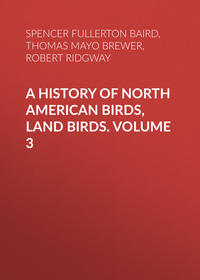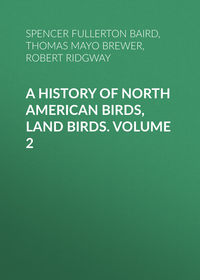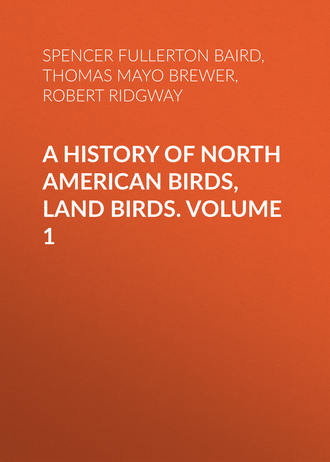 полная версия
полная версияA History of North American Birds, Land Birds. Volume 1
Other localities cited: Mexico, Sclater. Isthmus Panama, Lawrence. Veragua, Salv. Costa Rica, Lawr.
Sp. Char. Adult male. Upper parts and sides dark olive-green. Crown and sides of the head, including a triangular patch from behind the eye down the side of the neck, black, the feathers of the crown narrowly lunulated at tips with dark ash. A line from nostrils over the eye and encircling it (except anteriorly), with the entire under parts, bright yellow. No white on the tail. Female similar, with less black on the head. Length, 5 inches; wing, 2.95; tail, 2.25. Young not seen.
The adults in autumn are exactly the same as in spring.
Hab. Eastern Province of United States, north to Washington and Chicago; west to Republican Fork of Kansas River (Coues). Cuba, Guatemala, and Isthmus Panama. Not recorded from West Indies except Cuba.
Habits. The Kentucky Warbler is an abundant species in the Southern and Southwestern States, and has been found, though more rarely, as far to the north as Southern New York in the east and to Southern Wisconsin in the west. It has also been obtained at Fort Riley, in Kansas. Its nest and eggs have been procured near Cleveland, O., by Dr. J. P Kirtland, and also in Chester County, Penn., by Mr. Norris. It is a winter inhabitant in Mexico, Panama, Guatemala, and Cuba.
Wilson speaks of having met with this bird in abundance from Kentucky to the mouth of the Mississippi, everywhere quite common, but most especially so in the States of Tennessee and Kentucky. At the Balize he several times heard it twittering among the high rank grass of those solitary morasses. He found it frequenting low damp woods, and building its nest either in the middle of thick tufts of rank grass, in the fork of a low bush, or on the ground. The materials of which these nests were made were loose dry grass, mixed with the pith of wood, and lined with hair. He found the eggs from four to six in number, pure white, sprinkled with reddish specks. He met with the female sitting upon her eggs as early as May. These birds, he adds, are seldom seen among high branches, but prefer to frequent low bushes and canebrakes. In their habits they are very lively and sprightly. The song is loud, comprising three notes, and resembles tweedle-tweedle-dweedle. It makes its appearance in Kentucky from the South about the middle of April, and leaves the region about New Orleans on the approach of cold weather. Wilson was assured that it never remains there during the winter.
Wilson characterizes these birds as a reckless fighting species, almost always engaged in pursuing its fellows.
Mr. Audubon states that this Warbler is the most common and abundant species that visits the State of Louisiana and the whole region about the Mississippi River, but is not so common in Kentucky or Ohio. He describes it as an extremely lively and active bird, found in all the low grounds and damp places near watercourses, and generally among the tall rank weeds and low bushes growing in rich alluvial soil. It is continually in motion, hopping from stalk to stalk, and from twig to twig, preying upon insects, larvæ, or small berries, rarely pursuing an insect on the wing. He describes its song as agreeable and emphatic. He has never known this species fly farther than a few yards at a time. Its flight is low, and is performed in a gliding manner. It makes its first appearance about the middle of March, and remains until the middle or last of September. He states that it rears two broods in a season. His description of its nest, as “small, beautifully constructed, and attached to several stems of rank weeds,” etc., does not agree in position, size, or appearance with any that I have ever seen.
According to Mr. Audubon, it feeds largely upon spiders, which it obtains by turning over the withered leaves on the ground. The young birds resemble their mother until the following season, when the males attain the full beauty of their plumage. They remain with their parents until they migrate.
The late Dr. Alexander Gerhardt, an accurate and observing naturalist of Northern Georgia, informed me, by letter, that the nest of the Kentucky Warbler is usually built on the ground, under a tuft of grass, often on a hillside and always in dry places. The eggs are deposited from the 4th to the 15th of May. Nearly all the nests he met with were made externally of a loose aggregation of dry oak and chestnut leaves, so rudely thrown together as hardly to possess any coherence, and requiring to be sewed to be kept in place. The interior or inner nests were more compactly interwoven, usually composed of fine dark-brown roots. Instead of being small, they are large for the bird, and are inelegantly and clumsily made. They measure four inches in their diameter, three in height, and two in the depth of their cavity. One nest, the last received from Dr. Gerhardt, obtained by him at Varnell’s Station, in Northern Georgia, June 5, 1860, is large and peculiar in its construction. It is nearly spherical in shape, with an entrance partially on one side and nearly arched over. The periphery of this nest is composed exclusively of partially decayed deciduous leaves, impacted together, yet somewhat loosely. Within this outer covering is a fine framework of stems, twigs, and rootlets, and within this a snug, compact lining of hair and finer rootlets and fibres. This nest is six inches in diameter and five in height. It contained four eggs.
These eggs have an average length of .69 of an inch and a breadth of .56 of an inch. They have an oblong-oval shape, a crystalline-white ground, and the entire surface is sprinkled over with fine dots of red and reddish-brown. These, though most abundant about the larger end, are nowhere confluent, and do not form a crown.
A nest of this bird from Chester County, Penn., is a very flat structure, evidently built in a bed of fallen leaves. It has a diameter of six inches and a height of only two. The cup is a mere depression only half an inch in depth. Its base is loosely constructed of dried leaves, upon which is interwoven a coarse lining of long, dry, and wiry rootlets and stems of plants. It was given to Mr. J. P. Norris, from whom I received it, and it is now in the Boston collection.
Mr. Robert Ridgway furnishes the following valuable information in regard to the abundance and general habits of this species as observed in Southern Illinois: “It is a very common summer bird in Southern Illinois, where it arrives in the Wabash Valley towards the last of April. It is a wood-loving species, and of terrestrial habits, like the Seiurus aurocapillus, but generally frequents rather different situations from the latter bird, liking better the undergrowth of ‘bottom’ woods than that of dry forests. In all its manners it closely resembles the Seiuri, especially the two aquatic species, ludovicianus and noveboracensis, having the same tilting motion of the body, and horizontal attitude when perching, so characteristic of these birds. The nest I have never found, though well aware of its actual situation. I knew of one somewhere among the ‘top’ of a fallen tree, but it was so well concealed that the closest search did not enable me to discover it. In most cases the nest is probably on the ground, among the rubbish of fallen tree-tops, or low brushwood.
“The usual note of this Warbler is a sharp tship, almost precisely like that of the Pewee (Sayornis fuscus), uttered as the bird perches on a twig near the ground, continually tilting its body, or is changed into a sharp rapid twitter as one chases another through the thicket. Their song is very pretty, consisting of a fine whistle, delivered very much in the style of the Cardinal Grosbeak (Cardinalis virginianus), though finer in tone, and weaker.”
Dr. Coues found this Warbler rare at Washington, and chiefly in low woods with thick undergrowth, and in ravines. They were very silent, but not shy, and a few breed there.
Section GEOTHLYPEÆGenus GEOTHLYPIS, CabanTrichas, Swainson, Zoöl. Journ. III, July, 1827, 167 (not of Gloger, March, 1827, equal to Criniger, Temm.).
Geothlypis, Cabanis, Wiegmann’s Archiv, 1847, I, 316, 349.—Ib. Schomburgk’s Reise, Guiana, 1848.
Gen. Char. Bill sylvicoline, rather depressed, and distinctly notched; rictal bristles very short or wanting. Wings short, rounded, scarcely longer than the tail; the first quill shorter than the fourth. Tail long; much rounded or graduated. Legs stout; tarsi elongated, as long as the head. Olive-green above, belly yellow. Tail-feathers immaculate. Legs yellow.
Synopsis of SpeciesThroat yellow … Series I.
Throat ash … Series II.
Series IA. Black mask extending beneath the eye and on the auriculars.
1. G. trichas. Black mask bordered along its posterior edge with pale ashy or whitish; maxillæ black. Sexes dissimilar. ♀. Olive-brown above; throat only, distinctly yellow; no black mask. Juv. Without either black or pure yellow; above olive-brown, like ♀, beneath pale ochraceous-buff.
Abdomen almost always whitish; occiput russet-olive. Bill, from nostril, .30;. tarsus, .70; wing, 2.25; tail, 2.15. Hab. Whole of United States; in winter most of West Indies, and Middle America, north to Guatemala … var. trichas.
Colors similar; abdomen yellow. Bill, .45; tarsus, .90; wing, 2.50; tail, 2.50. Hab. Nassau; New Providence; Bahamas … var. rostrata.52
Abdomen bright yellow; occiput whitish-ash tinged with yellow. Bill, .32; tarsus, .75; wing, 2.45; tail, 2.50. Hab. Eastern Mexico (Jalapa?) … var. melanops.53
2. G. æquinoctialis. Black mask not bordered posteriorly by ashy or whitish; much narrower on forehead than on auriculars; maxillæ yellow. Sexes similar.
Black of the auriculars bordered posteriorly by the olive-green of the neck. Bill, .17 deep; wing, 2.50; tail, 2.35. Hab. Northeast South America (Cayenne, Trinidad, etc.) … var. æquinoctialis.54
Black of the auriculars bordered posteriorly by the ash of the crown. Bill, .14 deep; wing, 2.40; tail, 2.50. Hab. Brazil … var. velata.55
B. Black mask not extending underneath the eye, but confined to lores and frontlet.
3. G. poliocephala. Bill much as in Granatellus. Above olive-green; the crown light ash; beneath yellow. Sexes dissimilar.
Eyelids white; nape and auriculars olive-green; abdomen whitish. Bill, .30, .15 deep; wing, 2.20; tail, 2.50. Hab. West Mexico (Mazatlan) … var. poliocephala.56
Eyelids black; nape and auriculars ashy; abdomen wholly yellow. Bill, .35, .18 deep; wing, 2.40; tail, 2.50. Hab. Guatemala (Retaluleu) … var. caninucha.57
Series II4. G. philadelphia. Head all round ashy; lores only, black. Sexes nearly similar.
Eyelids dusky (except in ♀); a black patch on jugulum of ♂. ♀. Throat tinged with yellow. Hab. Eastern Province of North America; in winter south to Panama … var. philadelphia.
Eyelids white; no black patch on jugulum. ♀. Throat not tinged with yellow. Hab. Western and Middle Province of United States; in winter south to Costa Rica (Western Coast) … var. macgillivrayi.
Geothlypis trichas, CabanMARYLAND YELLOW-THROAT; BLACK-MASKED GROUND WARBLERTurdus trichas, Linn. S. N. 1766, 293. Sylvia trichas, Lath.; Aud., etc. Geothlypis trichas, Cab. Mus. Hein. 1850, 16.—Baird, Birds N. Am. 241; Rev. 220.—Gundlach, Cab. Jour. 1861, 326 (Cuba).—Sclater, Catal. 1861, 27, No. 167.—March, Pr. A. N. Sc. 1863, 293.—Lord, Pr. R. Art. Inst. Woolwich, IV, 1864, 115 (N. W. Boundary).—Jones, Nat. Bermuda, 29.—Samuels, 205.—Cooper, Orn. Cal. 1, 1870, 95. Sylvia marilandica, Wilson. Trichas mar. Bon. Regulus mystaceus, Stephens. Trichas personatus, Swainson. Sylvia roscoe, Aud. Trichas brachydactylus, Swains.
Other localities quoted: Xalapa, Oaxaca, Cordova, Scl. Guatemala, Scl. & Salv. Bahamas, Bryant. Costa Rica, Cab.; Lawr. Orizaba (autumn), Sum. Yucatan, Lawr.
Figures: Vieill. Ois. II, pl. xxviii, xxix.—Aud. Orn. Biog. I, II, V, pl. xxiii, cii, ccxl.—Wils. I, pl. vi, fig. 1.—Buffon, Pl. enl. 709, fig. 2.
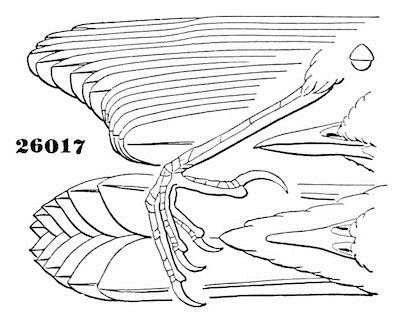
Geothlypis trichas.
26017
Sp. Char. (No. 26,024 ♂.) Wings a little shorter than the somewhat graduated tail. Bill slender, the depth contained about two and a half times in distance from nostrils to tip. First quill about equal to seventh. Forehead to above the anterior edge of the eye, and across the entire cheeks, ears, and jaws, and ending in an angle on sides of neck, black, with a suffusion of hoary bluish-gray behind it on the crown and sides of neck; the occipital and nuchal region grayish-brown, passing insensibly into the olive-green of the upper parts. Chin, throat, jugulum, edge of wing and crissum rich yellow (the latter paler); rest of under parts, with lining of wings, yellowish-white, the sides tinged with brownish; outer primary edged with whitish, the others with olive-green. Bill black; legs yellowish. Total length, 4.40; wing, 2.15; tail, 2.30; graduation, .25; width of outer tail-feather, .28; difference between first and third quills, .15; length of bill from forehead, .52; from nostril, .30; along gape, .60; tarsus, .75; middle toe and claw, .66; claw alone, .18; hind toe and claw, .48; claw alone, .26.
Male in winter, and the female, without the black mask; the forehead tinged with brown, the yellow of the throat less extended, the eyelids whitish, and a yellowish superciliary line.
Hab. The whole United States, from Atlantic to Pacific, and south to Costa Rica; Bermuda (October); Bahamas; Cuba; Jamaica.
The young bird is brownish-olive above, becoming more virescent on the rump and tail; eyelids, and whole lower parts, soft light buff, with a faint tinge of yellow on the breast and lower tail-coverts.
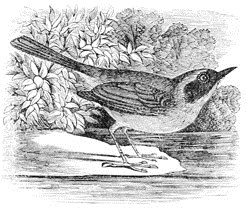
Geothlypis trichas.
There is very much variation manifested in a large series (containing more than one hundred and thirty specimens, principally North American), though but very little that accords with any distinctions of habitat. As a rule, however, those from the Atlantic States are the smallest of the series, and have most white on the abdomen, the yellow being restricted to the throat and jugulum, and the lower tail-coverts. In most specimens from the Mississippi Valley the yellow beneath is quite continuous, and the size considerably larger than in the series above mentioned, in these respects approaching the G. melanops from Eastern Mexico, in which the yellow pervades the whole surface beneath; but in this the whitish border above the black mask is extended over the whole crown, leaving the nape only distinctly brownish, and the size larger than the average of the series alluded to. However, No. 61,135 ♂, Liberty County, Ga., has even more white on top of the head, the whole occiput being of this color; while No. 7,922 ♂, from Racine, Wis., is quite as long as the type of melanops (the tail only, shorter), and there is nearly as much yellow beneath. The Georgia specimen, however, in other respects, is most like the Atlantic style. Specimens from the Pacific coast have just appreciably longer tails than Eastern ones, and the olive-green above is brighter. Jamaican and Guatemalan specimens are identical with many from the United States. The G. rostratus of Bryant, from the Bahamas, appears to be merely a gigantic insular race of the common species.
Habits. This well-known and beautiful little Ground Warbler is a common, abundant, and widely diffused species, occurring throughout the United States from ocean to ocean, and from the Gulf of Mexico to Canada and Nova Scotia. It is found, during the winter months, in Cuba, Jamaica, Mexico, Yucatan, Guatemala, Costa Rica, the Bahamas, and, in the fall, in Bermuda. On the Pacific coast it has been found from Cape St. Lucas to the British territories. It breeds from Northern Georgia to Halifax, inclusive.
In Central America, Mr. Salvin states that this Warbler is by far the most common of the Mniotiltidæ, but is wholly migratory. It was usually found in the neighborhood of water, frequenting the reeds that surrounded Lake Duenas, and the bushes on the banks of its outlet. It was also taken by Mr. Boucard at Totontepec, among the mountains of Oaxaca, Mexico.
It was observed as far to the north as Lake of the Woods, by Mr. Kennicott. Several were there observed, both males and females, May 29. It is everywhere quite common, and is, I think, as numerous in New England as in the Middle States.
For the most part it seems to prefer wild lands, especially those overgrown with briers and low bushes, to open or cultivated grounds. Yet this preference is not exclusive, as I have known a pair, or their offspring, to visit the same garden nine or ten successive summers. It is also more generally found in low lands than in high, and is probably attracted to moist thickets of briers and underbrush by the greater abundance of its favorite food. This Warbler is eminently terrestrial in its habits, never being found among higher limbs, but always either on the ground or among the lower branches of bushes, vines, and weeds. It is a diligent rather than an active or nimble bird, is always on the move, and incessantly in search of its food. This consists of insects in all their forms, but more particularly of larvæ, small beetles, and spiders. They are of great service in the destruction of several forms of injurious grubs, and but that their mode of life exposes them to destruction by prowling cats, I doubt not they would readily adapt themselves to living in our gardens. Occasionally they are found in fields of grain, where their presence is due to the abundance of destructive insects.
The Yellow-Throat appears shy and retiring because it prefers to move back and forth among low shrubs and brambles, where it most readily procures its food, but it is not a timid bird. They are unsuspecting, and will as readily permit as fly from the near presence of man. I have frequently had them approach within a few feet, especially when at rest; and even when in motion they will continue their lively song, as they move about from twig to twig. Though able to capture an insect on the wing, they are not expert fly-catchers, and chiefly take their prey when it is at rest.
Their song is a very lively and agreeable refrain, easily recognized, though exhibiting at times marked differences, and occasionally closely resembling the song of the Summer Yellow-Bird. The same brief series of notes, usually sounding like whi-ti-tēē-tēē, is constantly repeated at short intervals, while the singer continues his perpetual hunt for insects.
The male is very affectionate and devoted to both mate and offspring. The pair are never far apart, and during incubation the male is assiduous in the collection of food, feeding its mate, and afterwards assisting in collecting for their young. They rely upon concealment for the protection of their nest, and rarely show any open solicitude until it is discovered. Then they will make the most vehement demonstrations of alarm and distress, flying about the intruder and fearlessly approaching him to within a few feet. In Massachusetts they rarely, if ever, have more than one brood in a season. The young are able to take care of themselves early in July. At that time the song of the male ceases, or is abbreviated to a single whit, and parents and young form a family group and together hunt in the more secluded thickets, the edges of woods, and other retired places, for their food. Early in September they take their departure.
The Yellow-Throat is distributed, in suitable localities, over a large area, and wherever found is apparently equally common. Dr. Gerhardt found it quite abundant in Northern Georgia. Wilson and Audubon thought it more common in the Middle States than farther north, but I have found it quite as numerous about Halifax and Eastport as I have at Washington. Dr. Cooper speaks of it as “very common” in Washington Territory, though not so abundant as MacGillivray’s Warbler. The same writer also states it to be a “very common bird” in California. Their earliest arrival at San Diego was on the 17th of April, about the time they reach Pennsylvania. They appear in New England early in May.
Their nest is almost invariably upon the ground, usually in a thick bed of fallen leaves, a clump of grass or weeds, at the roots of low bushes or briers, or under the shelter of a brush-pile. Occasionally it has been found among high weeds, built in a matted cluster of branches, four or five feet from the ground. Sometimes it is sunk in a depression in the ground, and often its top is covered by loose overlying leaves. I have never found this top interwoven with or forming any part of the nest itself.
The nest is usually both large and deep for the size of the bird, its loose periphery of leaves and dry sedges adding to its size, and it often has a depth of from five to six inches from its rim to its base. The cavity is usually three inches deep and two and a quarter wide. Generally these nests are constructed on a base of dry leaves. An external framework, rudely put together, of dry grasses, sedge leaves, strips of dry bark, twigs, and decaying vegetables, covers an inner nest, or lining, of finer materials, and more carefully woven. At the rim of the nest these materials sometimes project like a rude palisade or hedge. Usually the lining is of fine grasses, without hair or feathers of any kind.
In some nests the outer portion and base are composed almost entirely of fine dry strips of the inner bark of the wild grape.
The eggs vary from four to six in number, and also differ greatly in their size, so much so that the question has arisen if there are not two species, closely resembling, but differing chiefly in their size. Of this, however, there is no evidence other than in these marked variations in the eggs.
In the Great Basin, Mr. Ridgway found this bird abundant in all the bushy localities in the vicinity of water, but it was confined to the lower portions, never being seen high up on the mountains, nor even in the lower portions of the mountain cañons.
Their eggs exhibit a variation in length of from .55 to .72 of an inch, and in breadth from .48 to .58 of an inch; the smallest being from Georgia, and the largest from Kansas. They are of a beautiful clear crystalline-white ground, and are dotted, blotched, and marbled around the larger end with purple, reddish-brown, and dark umber.
Geothlypis philadelphia, BairdMOURNING WARBLERSylvia philadelphia, Wils. Am. Orn. II, 1810, 101, pl. xiv; Aud.; Nutt. Trichas philadelphia, Jard.—Reinhardt, Vidensk. Meddel. for 1853, and Ibis, 1861, 6 (Greenland). Geothlypis phila. Baird, Birds N. Am. 1858, 243, pl. lxxix, fig. 3; Rev. 226.—Sclater, Catal. 1861, 27 (Orizaba).—Lawrence, Ann. N. Y. Lyc. 1861, 322 (Panama).—Samuels, 207.—Dresser, Ibis, 1865, 476.
Figures: Wils. Am. Orn. II, pl. xiv.—Aud. Birds Am. II, pl. ci.
Sp. Char. Wings but little longer than the tail, reaching but little beyond its base. Adult male. Head and neck all round, with throat and forepart of breast, ash-gray, paler beneath. The feathers of the chin, throat, and fore breast in reality black, but with narrow ashy margins more or less concealing the black, except on the breast. Lores and region round the eye dusky, without any trace of a pale ring. Upper parts and sides of the body clear olive-green; the under parts bright yellow. Tail-feathers uniform olive; first primary, with the outer half of the outer web, nearly white. Female with the gray of the crown glossed with olive; the chin and throat paler centrally, and tinged with fulvous; a dull whitish ring round the eye. Length, 5.50; wing, 2.45; tail, 2.25. Young not seen.
Hab. Eastern Province of United States to British America; Greenland; Southeastern Mexico, Panama R. R., and Colombia. Not recorded from West Indies or Guatemala. Costa Rica (Lawr.).




